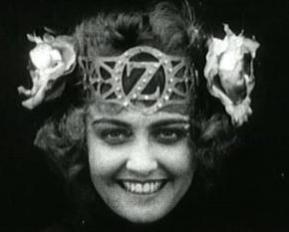
|
I
would like to take this opportunity to thank Marc Berezin
for taking the time - and having the patience - to alleviate
my ignorance of all things Oz. Thanks, Marc, for helping
me look smarter than I actually am!
|
Some people might wonder what's up with me and Oz. I know I do.
I mean, I've had the usual exposure to L. Frank Baum's creation,
by which I mean the 1939 movie was crammed down my throat every
holiday by network TV. Maybe more than the usual exposure,
as I actually bothered to read the book, The Wonderful Wizard
of Oz (if you have not yet, it is an eye-opening experience).
But starting with the beginning of this year, when I reviewed
Barry Mahon's cardboard version of The
Wonderful Land of Oz, this formerly faraway land has crept
more and more into my life. The DVDs for the two movies I examine
this week practically fell into my lap, causing me to delve more
deeply into Baum's neverland than I had ever intended. I find
myself itching to watch Return to Oz again, and that almost
frightens me.
These movies hail from a different time, a remove so far as to
almost border Oz itself: the silent era. If the general population
seems only vaguely aware that there are more than a couple of
Oz books, they are probably completely unaware that there were
at least eight Oz movies before the 1939 Judy Garland vehicle,
and numerous shorts.
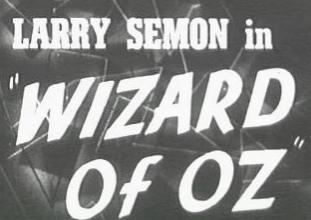 The
movie which began this journey for me opens with the legend "LARRY
SEMON in WIZARD OF OZ". Now again, you may be wondering,
"Larry who? And how did he get his name above the line?" I know I did, and I flatter myself as being fairly knowledgeable
about film. Larry Semon was a silent comedian, a contemporary
of Chaplin, Keaton and Lloyd; in his heyday, he was a bigger draw
and was paid more than the latter two. And Wizard of Oz
is arguably the movie that provided the deathblow to his career.
The
movie which began this journey for me opens with the legend "LARRY
SEMON in WIZARD OF OZ". Now again, you may be wondering,
"Larry who? And how did he get his name above the line?" I know I did, and I flatter myself as being fairly knowledgeable
about film. Larry Semon was a silent comedian, a contemporary
of Chaplin, Keaton and Lloyd; in his heyday, he was a bigger draw
and was paid more than the latter two. And Wizard of Oz
is arguably the movie that provided the deathblow to his career.
Going further into the movie provides us with Semon himself as
an old toymaker, working on doll versions of Dorothy, the Scarecrow,
and the Tin Woodman. He is interrupted by his granddaughter, who
begs him to read the Oz book to her; the pages of the storybook
become the opening credits. So far, so good.
Then things get… interesting, shall we say.
First, we are told that about eighteen years ago, a baby princess – the rightful ruler of Oz – disappeared, and Oz is
currently being governed by Prime Minister Kruel, aided of course,
by Lady Vishuss and Ambassador Wikked. Now, it may have taken
nearly two decades, but the people of Oz are now in Kruel's palace,
angrily demanding the return of their queen. They are barely held
in check by their spokesman, Prince Kynd.
Now, Baum did at one point write of a King Krewl (note different
spelling), but it was farther along in the Oz timeline, as it
were (and farther along in this review, too). The other characters
appear to be total persiflage, but let's get on with it. Kruel
is having a grand episode of silent movie angst at this popular
uprising, until Wikked suggests that he use "The Wizard". An intercard
informs us that "The Wizard was just a medicine-show hokum hustler,
but he fitted in nicely as the Prime Minister's 'yes-man'." Which
is close enough to the actual Wizard that the viewer starts
to feel like he may be watching the movie in a fever-dream delirium
(as if pondering the fact that Oz seems to be located in either
Eastern Europe or Russia didn't already do that) - but truthfully,
you ain't seen nothing yet.
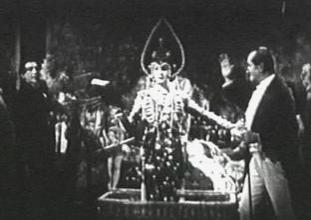 At
Kruel's command, "Do your stuff, Wizzy!" the Wizard produces,
from a huge wicker chest, "The Phantom of the Basket", a terrifying
transvestite whose impromptu dance number does a terrific job
of cowing the pre-Rocky Horror Picture Show peasants, despite
Prince Kynd's laughing assertion that it's all "a load of applesauce".
At
Kruel's command, "Do your stuff, Wizzy!" the Wizard produces,
from a huge wicker chest, "The Phantom of the Basket", a terrifying
transvestite whose impromptu dance number does a terrific job
of cowing the pre-Rocky Horror Picture Show peasants, despite
Prince Kynd's laughing assertion that it's all "a load of applesauce".
Meanwhile, back at the toymaker, the Moppet says, "Oh, Grammpy
– I don't like that. Read me about Dorothy, the Tin Woodman
and the Scarecrow." Audience worldwide doubtless chant "Go, Moppet,
Go, Moppet, Go!" At least those who were not chanting, "Gimme
my money back! Gimme my money back!" Of course, I am being sarcastic
in advance, but that's only because I've already seen the movie.
First we are assured that "In Kansas there bloomed a rose," before
we are introduced to Dorothy (Dorothy Dwan), who is a more mature
protagonist than we are used to, quite beyond the 16 year-old
Judy Garland in the later version. Dwan was around twenty at the
time of filming, and even with the strange Clara Bow-type lipstick
that makes her look like she is constantly puckering up for a
kiss, it's obvious that Ms. Dwan is a indeed a very pretty lady.
Of course, she's also shot very well, as we are looking at the
future Mrs. Larry Semon. She looks like an Alphonse Mucha print
come to life. But I'm getting ahead of myself.
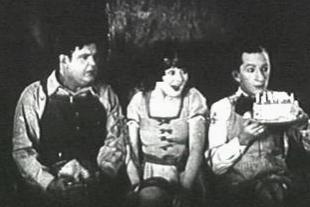 The
movie does a quick job of introducing the remainder of our cast – Auntie Em (Mary Carr), who will quickly vanish from the
proceedings; Uncle Henry (Frank Alexander), a man whose girth
is so large he is practically a cylinder; and two farmhands/suitors
to Dorothy, who are never given names, but are played by Larry
Semon and a very young (and almost thin) Oliver Hardy.
The
movie does a quick job of introducing the remainder of our cast – Auntie Em (Mary Carr), who will quickly vanish from the
proceedings; Uncle Henry (Frank Alexander), a man whose girth
is so large he is practically a cylinder; and two farmhands/suitors
to Dorothy, who are never given names, but are played by Larry
Semon and a very young (and almost thin) Oliver Hardy.
Special mention must be made at this point to another character:
Snowball (Spencer Bell), who is a stock character familiar to
anyone who's made a study of popular entertainment in the first
half of the 20th Century – the Comical Negro Rascal.
Yes, CNR's were a fixture of low comedy in those days, a carryover
from the blackface minstrel shows on the vaudeville circuits which
were still traveling the country at the time. You can count on
certain things from a CNR: 1) Excessive laziness; 2)
General tremulousness, usually coupled with extreme superstition;
3) Komedic density in the brains department; 4) An
obsession for watermelon. The CNR reached its nadir in the studio-created
persona of Sleep'n'Eat (actually comedian Willie Best), and reached
its apex in the various terrified, but no less warmly human, characters
essayed by the great Mantan Moreland.
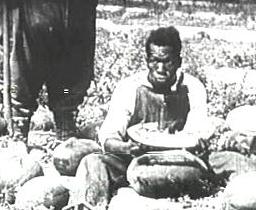 It
would be easy to dismiss the character of Snowball out of hand
as mere stereotypical racist humor – note how Bell is here
saddled with the pseudonym G. Howe Black (and I am deeply ashamed
for not noticing that atrocious pun the first time through). But
to do that would actually diminish the fine work done here by
Bell and later comedians like Moreland: working within the strictures
imposed on them by the studios (and yes, the mores of the time):
these men manage to turn in some tremendously funny performances.
Everyone in this production of Wizard of Oz is a cartoon
character (some toons, I think, would be insulted by that comparison),
and if you choose to be offended by Spencer Bell earning a living,
you might as well also be offended by the indignities visited
upon Frank Alexander simply because he is obese, and therefore
a target of many punch lines. You're never going to see another
CNR in these times (well, not outside Spike Lee's pictures, anyway),
but I'll bet I'll see some fat guy humiliated on TV sometime this
week, or at the very least in Troma's latest offering.
It
would be easy to dismiss the character of Snowball out of hand
as mere stereotypical racist humor – note how Bell is here
saddled with the pseudonym G. Howe Black (and I am deeply ashamed
for not noticing that atrocious pun the first time through). But
to do that would actually diminish the fine work done here by
Bell and later comedians like Moreland: working within the strictures
imposed on them by the studios (and yes, the mores of the time):
these men manage to turn in some tremendously funny performances.
Everyone in this production of Wizard of Oz is a cartoon
character (some toons, I think, would be insulted by that comparison),
and if you choose to be offended by Spencer Bell earning a living,
you might as well also be offended by the indignities visited
upon Frank Alexander simply because he is obese, and therefore
a target of many punch lines. You're never going to see another
CNR in these times (well, not outside Spike Lee's pictures, anyway),
but I'll bet I'll see some fat guy humiliated on TV sometime this
week, or at the very least in Troma's latest offering.
Dang, how did that soap box sneak under my feet? Where was I?
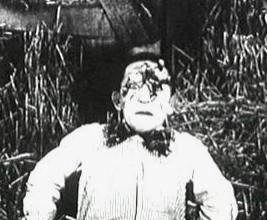 It's
incredibly easy to get sidetracked in examining this production
of Wizard, because for the next 35 minutes or so, it is
basically a slapstick comedy that has nothing to do with Baum's
book (as we will see, the phrase "it is basically a slapstick
comedy that has nothing to do with Baum's book" could form
the entire review, and we could all go back to doing something
more constructive, like grumbling that every movie forthcoming
from Hollywood is going to suck). Hardy and Semon will vie for
Dorothy's affections, a variety of farm animals will expectorate
on Semon in a variety of ways (it is oddly creepy when a hen drops
an egg on the napping Semon's head, and in order for the mess
to show up against Semon's white facial makeup, the goo inside
the egg is black), and a swarm of cartoon bees will affix
themselves to Frank Alexander's ponderous ass. Hilarity ensues.
It's
incredibly easy to get sidetracked in examining this production
of Wizard, because for the next 35 minutes or so, it is
basically a slapstick comedy that has nothing to do with Baum's
book (as we will see, the phrase "it is basically a slapstick
comedy that has nothing to do with Baum's book" could form
the entire review, and we could all go back to doing something
more constructive, like grumbling that every movie forthcoming
from Hollywood is going to suck). Hardy and Semon will vie for
Dorothy's affections, a variety of farm animals will expectorate
on Semon in a variety of ways (it is oddly creepy when a hen drops
an egg on the napping Semon's head, and in order for the mess
to show up against Semon's white facial makeup, the goo inside
the egg is black), and a swarm of cartoon bees will affix
themselves to Frank Alexander's ponderous ass. Hilarity ensues.
There are some plot points, though. Dorothy was left on Em and
Henry's doorstep when but a baby, with a note saying an attached,
sealed letter should not be opened until her 18th birthday.
Kruel, it turns out, is the one who abducted the princess – Dorothy - and placed her on the doorstep. As far as Evil Plans
go, this ranks somewhere slightly above giving James Bond a book
entitled How To Foil My Evil Plans For World Domination For
Dummies and then strenuously hoping he doesn't read it. But
only slightly. Admittedly, it does give Kruel eighteen years to
think of something better, but it is also apparent that he has
been doing nothing but playing that new Godzilla game on the GameCube
for the last couple of decades, as the best thing he can come
up with is to send Wikked to Kansas to steal the letter before
Dorothy can read it and realize she is the rightful Queen of Oz.
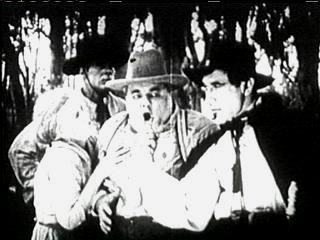 Wikked
and four henchmen – dressed, for some reason, like gauchos
(maybe they're in disguise? I can hear it now: "Gauchos in Kansas?
No one will suspect a thing!") - arrive in a biplane and demand
the letter. When Henry tells them to get lost, Wikked bribes Hardy
to find the letter, and when that fails, has his men hoist Dorothy
to the top of a tower (its exact purpose on the farm unknown)
and set fire to the rope supporting her until Henry relents and
hands over the letter.
Wikked
and four henchmen – dressed, for some reason, like gauchos
(maybe they're in disguise? I can hear it now: "Gauchos in Kansas?
No one will suspect a thing!") - arrive in a biplane and demand
the letter. When Henry tells them to get lost, Wikked bribes Hardy
to find the letter, and when that fails, has his men hoist Dorothy
to the top of a tower (its exact purpose on the farm unknown)
and set fire to the rope supporting her until Henry relents and
hands over the letter.
As we will soon see, this is another standard in Larry Semon
movies – people in jeopardy on tall structures. In fact,
during this segment, Hardy will pursue Semon to the top of a grain
silo. It's like watching proto-Jackie Chan material, except it
is obvious from the reliance on far shots that it's not Semon,
but a stuntman who does the dangerous work, like leaping from
the silo into a wagon full of hay (which doesn't diminish the
thrill of the stunt, I might add). Hardy similarly leaps from
the silo (okay, stuntman again), but Semon has moved the wagon.
Luckily, the impact doesn't seem to harm Hardy much. Similarly,
Dorothy dangling from the rope is patently a man. When the rope
finally breaks, Semon races below to catch her, resulting in both
actors extricating themselves from a deep impact crater.
I told you these were cartoon characters.
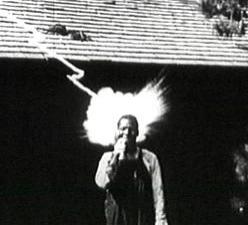 Anyway,
after thirty-five minutes of such nonsense, God has had enough
and throws a tornado at the movie. Mysteriously, it is Hardy,
Semon, Henry, Wikked and Dorothy who are airlifted in a
small storage barn to Oz. Snowball – after cartoon lightning
has komedically and uselessly bounced off his noggin several times
– is pursued across the sky by lightning so he winds up in
Oz, too.
Anyway,
after thirty-five minutes of such nonsense, God has had enough
and throws a tornado at the movie. Mysteriously, it is Hardy,
Semon, Henry, Wikked and Dorothy who are airlifted in a
small storage barn to Oz. Snowball – after cartoon lightning
has komedically and uselessly bounced off his noggin several times
– is pursued across the sky by lightning so he winds up in
Oz, too.
Hey, we’re finally in Oz! And judging from the onion domes
in the cityscape, it is in Russia. A welcoming committee
comprised of Kynd, Kruel, and a flock of soldiers greets them.
Although Kynd reads the letter and realizes that Dorothy is the
rightful queen returned to them, Kruel accuses the others of being
the kidnappers and commands the Wizard to turn them into "monkeys…
anything!" Realizing they are all in the same boat, the Wizard
appeals to Hardy and Semon to help him out, and…
…Are you ready?… Are you sure?
…in the ensuing chase scenes, Semon takes refuge in a cornfield,
and Hardy hides in a junkyard full of cast-off metal parts. When
Kruel demands to know the refugees whereabouts, the Wizard replies
he has transformed them – and enter Semon and Hardy disguised
as the Scarecrow and the Tin Woodman.
Um hm.
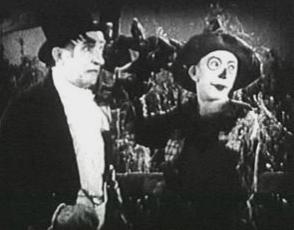
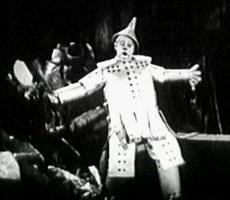 This
terrifies the soldiers for a bit, until Wikked pulls out a literal
cannon and starts lobbing shells at our heroes. They surrender,
and are taken into Oz, where Kynd tells them that until he has
time to sort things out, the "guilty ones" will have to stay in
the dungeon. Hardy, being slightly overweight and therefore a
villain, proclaims Semon to be the guilty one. In a moment that,
to my embittered post-modern eye seems a case of racial profiling,
Snowball is the only one tossed in the dungeon. But then Semon
goes down the hole, too, but in the interim the ladder has been
removed, so the comedian – still in Scarecrow drag, as he
will be for the rest of the picture- falls from a great height.
Again.
This
terrifies the soldiers for a bit, until Wikked pulls out a literal
cannon and starts lobbing shells at our heroes. They surrender,
and are taken into Oz, where Kynd tells them that until he has
time to sort things out, the "guilty ones" will have to stay in
the dungeon. Hardy, being slightly overweight and therefore a
villain, proclaims Semon to be the guilty one. In a moment that,
to my embittered post-modern eye seems a case of racial profiling,
Snowball is the only one tossed in the dungeon. But then Semon
goes down the hole, too, but in the interim the ladder has been
removed, so the comedian – still in Scarecrow drag, as he
will be for the rest of the picture- falls from a great height.
Again.
Did I mention the dungeon seems to be run by pirates? Yeah, I
thought that was strange, too. Maybe Oz is landlocked and they
just couldn't find any other employment. Though it must be said
that they seem to be having a grand time of it. I guess it's just
in their nature to try and find some enjoyment in whatever they
do. I envy people like that.
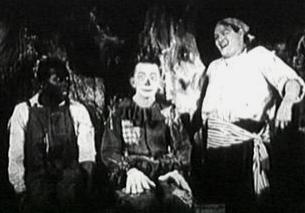 Anyway.
For his part in this treachery, Hardy is proclaimed "the 'Knight
of the Garter' – so in the future no metal could touch him"
and Henry is made "The Prince of Whales", har de frickin' har.
Auntie Em, we must hope, has sold what was left of the farm in
Kansas and is now living the high life in Vegas. Kruel plots to
retain his grip on power by wooing Queen Dorothy, while Prince
Kynd – hell, I don't know what Kynd is doing, but he sure
doesn't seem to pursuing his investigation. Maybe he's got a GameCube,
too. Semon and Snowball are still in the dungeon, where the pirates
are filling up a vat with something gooey. The mind offers all
sorts of possibilities of what that gooey something might be.
Molten lead, mud, poop – for all I know it's chocolate syrup.
Then for some reason they toss one of their own into it and he
doesn't seem to enjoy the experience. A pirate informs Semon he's
next. Or maybe they'll throw him to the lions. Yep, they keep
lions in the dungeon. Strange place, that Oz.
Anyway.
For his part in this treachery, Hardy is proclaimed "the 'Knight
of the Garter' – so in the future no metal could touch him"
and Henry is made "The Prince of Whales", har de frickin' har.
Auntie Em, we must hope, has sold what was left of the farm in
Kansas and is now living the high life in Vegas. Kruel plots to
retain his grip on power by wooing Queen Dorothy, while Prince
Kynd – hell, I don't know what Kynd is doing, but he sure
doesn't seem to pursuing his investigation. Maybe he's got a GameCube,
too. Semon and Snowball are still in the dungeon, where the pirates
are filling up a vat with something gooey. The mind offers all
sorts of possibilities of what that gooey something might be.
Molten lead, mud, poop – for all I know it's chocolate syrup.
Then for some reason they toss one of their own into it and he
doesn't seem to enjoy the experience. A pirate informs Semon he's
next. Or maybe they'll throw him to the lions. Yep, they keep
lions in the dungeon. Strange place, that Oz.
Enter the Wizard, who has Snowball put on a lion suit to terrorize
the guards. Because I know you were wondering, where exactly is the Cowardly Lion? And I say unto you: ask and ye shall receive…sucker!
In the ensuing chaos, Semon sneaks back upstairs to warn Dorothy
of the plots against her. This results in a) Uncle Henry
falling into the vat of goo (komedy gold!); and b) an extended
chase scene as Hardy and his minions pursue Semon through the
dungeons. This is a pretty good scene, as Semon keeps hiding in
wooden crates and magically teleporting out of them before Hardy
smashes them. Eventually though, Semon unwittingly takes refuge
in the lion cage, and of course mistakes a real lion for Snowball
in that costume.
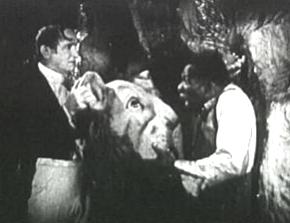 Meanwhile,
Kruel puts the moves on Dorothy with all the subtlety of a frat
boy after a keg and a half. This scene of sexual harassment is
interrupted by Kynd, and the resulting swordfight is interrupted
by even more treachery, as one of Kruel's henchmen surprises
Kynd from behind. Semon save Kynd's butt, not once, but twice,
and his reward? Dorothy gives him a kiss and declares her love
for Prince Kynd. I think even the women in the audience are, at
this point, thinking, "Bitch!"
Meanwhile,
Kruel puts the moves on Dorothy with all the subtlety of a frat
boy after a keg and a half. This scene of sexual harassment is
interrupted by Kynd, and the resulting swordfight is interrupted
by even more treachery, as one of Kruel's henchmen surprises
Kynd from behind. Semon save Kynd's butt, not once, but twice,
and his reward? Dorothy gives him a kiss and declares her love
for Prince Kynd. I think even the women in the audience are, at
this point, thinking, "Bitch!"
Well, no time for that, Hardy and his minions come from the dungeon
to pursue Semon some more. Up a water tower (another Semon motif),
no less. Semon pauses long enough on the ladder to turn and send
Hardy plummeting. Once atop the tower, Semon is seemingly trapped
when Wikked once again employs that damned cannon... until Snowball
arrives, flying a biplane. Semon grabs the dangling rope
ladder, and all seems well, until the rope ladder snaps…
And the Moppet awakens from a dream, snatches away the Scarecrow,
Woodsman and Dorothy dolls for safe keeping, and runs back up
the stairs, away from the Toymaker and this strange, hellish vision
of Oz, doubtless to cry herself back to sleep. After all, Hardy's
dead body doubtless lies shattered after his fall from the tower,
Semon's corpse is splattered all over some borscht field, and
the feckless Dorothy is makin' whoopee with some guy in a uniform
whom she just met. If there is any sunshine offered by this turn
of events, it is that hopefully Snowball found out that there
were fully loaded machine guns on the biplane, and is currently
merrily strafing a Ku Klux Klan rally.
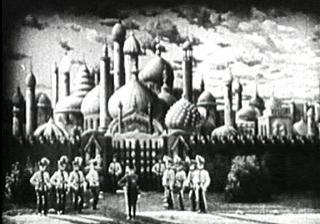 I,
personally, was desperate for some denouement here, where
it might be revealed that the Toymaker can't really read, and
has been making up everything we just saw to simply satisfy his
grand-daughter and get the little hellion to shut up; but that
particular comforting straw is snatched from my grasp, as the
old man returns to his book and reads, "And Queen Dorothy and
her Prince lived happily ever after! The End."
I,
personally, was desperate for some denouement here, where
it might be revealed that the Toymaker can't really read, and
has been making up everything we just saw to simply satisfy his
grand-daughter and get the little hellion to shut up; but that
particular comforting straw is snatched from my grasp, as the
old man returns to his book and reads, "And Queen Dorothy and
her Prince lived happily ever after! The End."
You are likely thinking something along the lines of '-the hell?" after reading this description. Chances are, so were the audiences
of the time, though with an additional layer of resentment and
dismay.
Like his contemporaries, Larry Semon was attempting to make the
transition from two-reel comedies to feature-length entertainment.
By all accounts, the comedian had wanted to make an Oz movie for
quite some time, and after the critical and box office failure
of his first feature (the 1924 The Girl in the Limousine),
he paid a large amount to the Baum estate for the movie rights
and spent some time working with Baum's son on the script. Then,
somehow, for some reason, he transformed all this into an 83 minute
Larry Semon two-reeler.
At this point I'll have to defer to an expert. Richard M. Roberts,
in an exhaustively researched and excellent
series of three
articles for Classic
Images magazine,
puts it this way:
| For
years, the available Semon films were the ones from his
years of decline, the 1924-28 Educational comedies, including
his unfortunate remake (yes, remake, don't forget L. Frank
Baum had made films in the teens) of The Wizard of Oz.
What was apparent from these films, and the few Vitagraph
films that were extant, was not only the hectic quality
of his filmmaking, but the sameness of it all. One could
almost compose a standard recipe for a Larry Semon comedy:
Mix:
- 1.
Larry
Semon;
- 2.
A heroine (usually Larry's current girlfriend or wife);
- 3.
A fat guy (usually Oliver Hardy to play the villain);
- 4.
A really fat guy (usually Frank Alexander, to play Larry's
current girlfriend's father);
- 5.
Several stuntmen, one to play Larry in everything but
mid-close shots and close-ups, and several more to be
thrown off things;
- 6.
Things to throw the stuntmen off of, usually water towers,
barns, silos, smokestacks, or buildings in general;
- 7.
Gooey or messy things, frequently utilized to dump onto
the really fat guy or the really fat guy into. Includes
but is not relegated to, mud baths, wet cement, large
washtubs filled with eggs, flour sacks, feather pillows,
and large pots or buckets labeled in large block letters
GLUE, INK, JAM, MOLASSES, etc., and filled to the brim
with said items;
- 8.
Several mechanical means of transportation, including
airplanes, motorcars, trains, and motorcycles;
- 9.
Explosions, frequently used to destroy the things listed
in numbers 6 and 8;
- 10.
Plot (optional).
|
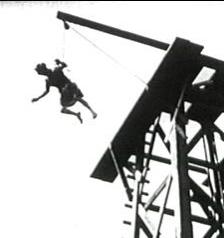 That
is sheer genius and there is no way I can improve upon it. Each
and every one of these things does indeed appear in Wizard
of Oz, and it was this stolid sameness, even more than the
cavalier discarding of actual elements from the book, that caused
the negative audience response. Even within the movie, it gets
repetitious: the climbing up a tall structure at the slightest
provocation, and in defiance of all logic; the constant goo, the
dogged ignoring of any plot line in favor of komedic opportunities.
The same setup is used twice: Semon trying to escape something
menacing, but to be frustrated when even the tiniest step is harried
and chivvied by the menace – first by animated lightning,
then a prop lion's paw.
That
is sheer genius and there is no way I can improve upon it. Each
and every one of these things does indeed appear in Wizard
of Oz, and it was this stolid sameness, even more than the
cavalier discarding of actual elements from the book, that caused
the negative audience response. Even within the movie, it gets
repetitious: the climbing up a tall structure at the slightest
provocation, and in defiance of all logic; the constant goo, the
dogged ignoring of any plot line in favor of komedic opportunities.
The same setup is used twice: Semon trying to escape something
menacing, but to be frustrated when even the tiniest step is harried
and chivvied by the menace – first by animated lightning,
then a prop lion's paw.
But then I also have to say that unlike then-contemporary audiences,
I haven't been watching Larry Semon comedies for the last
ten years, and though I didn't find anything truly new or innovative
in Wizard of Oz, it is all very well and professionally
done. Once I got used to the fact that I was watching a slapstick
comedy (and, at best, the reels of film might have once
sat in the same room with a copy of the book whose name it bears),
I was actually entertained and downright amused several times.
Technically, there is some amazing stuff in here, clever use of
animation, double exposure, and miniatures. This Wizard of
Oz might have bankrupted everybody even remotely associated
with it, but a generous portion of the budget is on the screen.
I suppose the major reason I find myself writing about this is
that, yes, Virginia, it proves a point, and that is the much-derided
trend for "re-imagining" properties in Hollywood is about as new
as this 1925 production, ie, not at all (let's not forget
the silent version of Romeo and Juliet with the happy ending).
Why Larry Semon paid good money for a property and then turned
it into a fabulously expensive rehash of his entire career is
lost to the ages - Semon himself suffered a nervous breakdown
and then expired from pneumonia in 1928. Although all but unknown
here in America, he is still popular in Europe, and on the basis
of this one movie I can see why. As an adaptation of Wizard
of Oz, it fails in a classically tragic manner, but as a Larry
Semon movie, it is perfection – especially as a single dose.
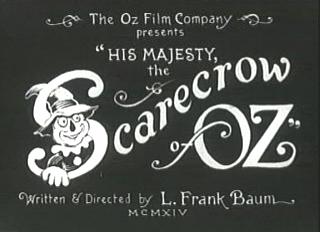 It
also propelled me into examining another relic from the silent
age, in fact, one made even earlier – His Majesty the
Scarecrow of Oz, written and directed by L. Frank Baum himself.
Its pedigree should surprise no one, as Baum was involved in theatrics
of one kind or another throughout his life. Let's see if I can
get through this without rapping out another 3500 words. The fact
that the small DVD player I have wired to my computer refuses
to have anything to do with the Brentwood disc might make that
easier.
It
also propelled me into examining another relic from the silent
age, in fact, one made even earlier – His Majesty the
Scarecrow of Oz, written and directed by L. Frank Baum himself.
Its pedigree should surprise no one, as Baum was involved in theatrics
of one kind or another throughout his life. Let's see if I can
get through this without rapping out another 3500 words. The fact
that the small DVD player I have wired to my computer refuses
to have anything to do with the Brentwood disc might make that
easier.
Once again we start with King Krewl – but relax, this time
he's Canon – who wants his daughter Princess Gloria to marry
a courtier named Googly Goo. Gloria, however, realizes that "Mrs.
Goo" is not a monicker she wants to carry around for the rest
of her life, and turns the fop down flat. Besides, she's fallen
in love with the gardener's son, Pon – something that does
not sit well with Krewl (well, come on, with a name like that,
how could it?).
In the meantime, some guys assemble a scarecrow in a field, only
to have some 1915 hotties in Indian drag materialize from the
cornfield and do a dance around the straw man, bringing him to
life. Then, they vanish, leaving the poor guy hung up on his crosspiece.
The lesson learned here, just as in Children of the Corn,
is that those cornfield spirits are real jerks.
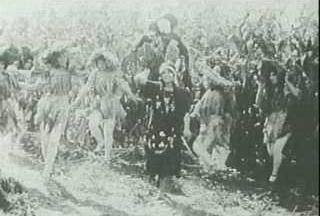 In
the meantime meantime, a girl from Kansas named Dorothy
is wandering around Oz – never mind how, we don’t have
time for that – and is captured by the evil witch Mombi,
who puts the girl to work in her kitchen, just in time for Krewl
and Googly Goo to bring in the unwilling Gloria. Krewl commands
Mombi to "freeze her heart, so she'll never love another mortal." Mombi calls upon her three sister witches to aid in this, and
these four witches are an absolute stitch, one of my favorite
parts of the movie (I especially like the crone in the bat getup).
The three weird sisters then turn into three hotties to work the
spell. You know, Oz can be a strange, frightening place, but I'm
sure it's current allure to me is the fact that it seems to be
densely populated by hotties. Sure, there are problems with witches
and large, strange animals, but hell, that sounds just like Texas.
In
the meantime meantime, a girl from Kansas named Dorothy
is wandering around Oz – never mind how, we don’t have
time for that – and is captured by the evil witch Mombi,
who puts the girl to work in her kitchen, just in time for Krewl
and Googly Goo to bring in the unwilling Gloria. Krewl commands
Mombi to "freeze her heart, so she'll never love another mortal." Mombi calls upon her three sister witches to aid in this, and
these four witches are an absolute stitch, one of my favorite
parts of the movie (I especially like the crone in the bat getup).
The three weird sisters then turn into three hotties to work the
spell. You know, Oz can be a strange, frightening place, but I'm
sure it's current allure to me is the fact that it seems to be
densely populated by hotties. Sure, there are problems with witches
and large, strange animals, but hell, that sounds just like Texas.
Anyway. Through a series of dissolves, Mombi actually
removes Gloria's heart – no surprise, it's shaped like a
valentine – makes icicles grow on it, and then replaces it.
This is witnessed by a horrified Dorothy and Pon, who manage to
escape with the somewhat comatose Princess Gloria, with Mombi
in hot pursuit.
And therein lies your basic plot for the picture: they free the
scarecrow from his perch, Pon gets turned into a kangaroo, they
come upon the Tin Woodman – as usual, rusted into immobility
– and eventually the Cowardly Lion and even the Wizard get
entangled in the proceedings. If you're wondering about the title
of the picture, our heroes eventually lay siege to the castle
of King Krewl, and when the Scarecrow captures the ramparts by
simply ignoring all the arrows festooning his body – well,
the cowardly, superstitious bad guys immediately make him king.
Wouldn't you? And if you don't think everything will come out
all right in the end, you don't know your children's fantasy very
well.
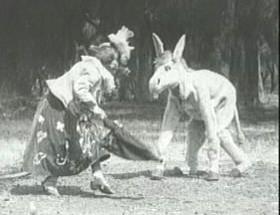 As
a compare-and-contrast with Larry Semon's "version" (and I can
feel the quotation marks wincing as they are forced to bracket
that word), Baum's last movie is going to be heavy on the contrast
side; if Semon barely acknowledges the existence of the mythology
of Oz, His Majesty the Scarecrow is soaked in it. Produced
closer to the series' peak in popularity, there are going to be
several instances when today's audience is going to be totally
at sea, as they're unfamiliar with the series as a whole. They're
going to wonder why a jackass is engaged in Mortal Kombat™
with Mombi because they won't recognize Hank the Mule; similarly,
when the Wizard makes his appearance in a wagon drawn by the Sawhorse,
anybody unfamiliar with Tip's creation from the second book is
simply going to assume that this guy and his creature wandered
in from a nearby David Lynch movie. It also doesn't help that
the picture plays very loose with the established Oz timeline.
After all, we start with Dorothy's arrival and the origin of the
Scarecrow – then, later, Dorothy and the Scarecrow will greet
the Tin Woodsman and the Wizard like old friends, but Dorothy
will not recognize the Cowardly Lion, though the Scarecrow and
Woodsman do. It can make your head hurt, it can.
As
a compare-and-contrast with Larry Semon's "version" (and I can
feel the quotation marks wincing as they are forced to bracket
that word), Baum's last movie is going to be heavy on the contrast
side; if Semon barely acknowledges the existence of the mythology
of Oz, His Majesty the Scarecrow is soaked in it. Produced
closer to the series' peak in popularity, there are going to be
several instances when today's audience is going to be totally
at sea, as they're unfamiliar with the series as a whole. They're
going to wonder why a jackass is engaged in Mortal Kombat™
with Mombi because they won't recognize Hank the Mule; similarly,
when the Wizard makes his appearance in a wagon drawn by the Sawhorse,
anybody unfamiliar with Tip's creation from the second book is
simply going to assume that this guy and his creature wandered
in from a nearby David Lynch movie. It also doesn't help that
the picture plays very loose with the established Oz timeline.
After all, we start with Dorothy's arrival and the origin of the
Scarecrow – then, later, Dorothy and the Scarecrow will greet
the Tin Woodsman and the Wizard like old friends, but Dorothy
will not recognize the Cowardly Lion, though the Scarecrow and
Woodsman do. It can make your head hurt, it can.
And I must pause here to make special mention of Frank
Woodward, who plays all the animals in this movie – The Cowardly
Lion, Hank the Mule, the kangaroo, a giant jackdaw, a cow – the man puts on a bewildering variety of costumes, uses forearm
crutches to give himself properly long front legs, and manages
to make every creature an individual. In most examinations of
this movie, you'll find folks giving Woodward praise for his work
here, and I'm not going to be any different. A large part of the
magic ambience of this Oz rests on his shoulders, and he is more
than capable of bearing that burden.
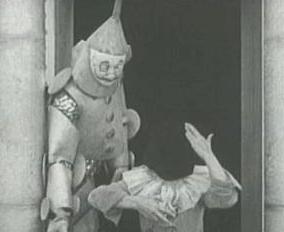 Speaking
of disturbing – remember, we were, back with David Lynch?
You tend to forget just how violent a place Oz can be. That's
one of the things I carry with me from my youthful reading of
the first book – the Woodman got to use that axe a lot, protecting
the others. Similarly, the Lion wasn't all that cowardly,
when some of the fierce wild creatures of Oz attacked. In this
outing, we get to see the enraged Mombi take the living Scarecrow
apart with her bare hands (yeah, that happened in the '39 version,
too, and it scared the crap out of me then), and later,
the Woodman will return the favor by lopping off Mombi's head.
That would also be frightening if the mechanics of the effect
weren't so transparent – the black bag over the actress'
head is too well lit from the side for it to be truly effective.
Speaking
of disturbing – remember, we were, back with David Lynch?
You tend to forget just how violent a place Oz can be. That's
one of the things I carry with me from my youthful reading of
the first book – the Woodman got to use that axe a lot, protecting
the others. Similarly, the Lion wasn't all that cowardly,
when some of the fierce wild creatures of Oz attacked. In this
outing, we get to see the enraged Mombi take the living Scarecrow
apart with her bare hands (yeah, that happened in the '39 version,
too, and it scared the crap out of me then), and later,
the Woodman will return the favor by lopping off Mombi's head.
That would also be frightening if the mechanics of the effect
weren't so transparent – the black bag over the actress'
head is too well lit from the side for it to be truly effective.
But if you want really frightening… well, it's interesting
to compare how far along the craft of cinema had come in the ten
years between these two pictures. Semon's storytelling, while
hectic, is pretty well streamlined; the acting, while melodramatic,
is clear and concise. In 1915, in defiance of the fact that the
movie is silent, the actors seem to jabber constantly,
their mouths perpetually working. For me – and I can find
no rational reason for this – that practice transforms the
Scarecrow from a lovable, loose-jointed character to a gibbering,
flailing homunculus that fills me with some eldritch, superstitious
dread. It is the damnedest thing, that a scene in which
the Scarecrow discovers water by falling into a stream, and reacts
with delight, instead frightens me deeply.
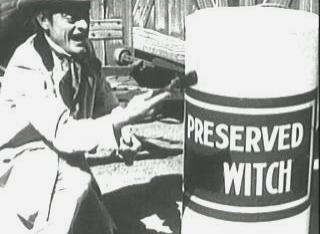 Ah,
well, the '39 version gave me nightmares, too.
Ah,
well, the '39 version gave me nightmares, too.
Yes, Baum may not have been technically the filmmaker that Semon
was, but his movie version possesses something the later comedy
does not: whimsy, that quality that cannot be learned or bought,
but must be produced full-born from the heart. Baum had both in
great quantities, and His Majesty the Scarecrow of Oz,
though strange and not a little remote to our modern eyes, is
a fine testament to that fact. Both movies are well worth seeking
out – but only if you are willing to meet them on their own
terms, as they are similar in name only and wholly disparate in
intent.
Finally, turn off the sound - the audio on these discs is horrible.